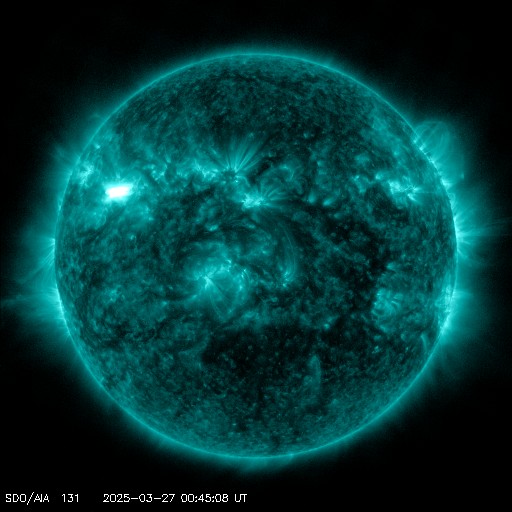Viewing archive of Friday, 28 March 2003
Solar activity report
Any mentioned solar flare in this report has a scaling factor applied by the Space Weather Prediction Center (SWPC). Because of the SWPC scaling factor, solar flares are reported as 42% smaller than for the science quality data. The scaling factor has been removed from our archived solar flare data to reflect the true physical units.
Report of Solar-Geophysical Activity 2003 Mar 28 2200 UTCPrepared by the NOAA © SWPC and processed by SpaceWeatherLive.com
Joint USAF/NOAA Report of Solar and Geophysical Activity
SDF Number 087 Issued at 2200Z on 28 Mar 2003IA. Analysis of Solar Active Regions and Activity from 27-2100Z to 28-2100Z
Solar activity was low due to a single C1 flare at
27/2325Z, likely associated with activity from near the southwest
limb. Region 319 (N12W18) has stabilized following a period of
rapid growth in the previous 24 hours. Despite its moderate size,
this region maintains a fairly simple magnetic configuration and has
been stable. Region 321 (N04E21) exhibited slight decay and was
relatively quiet this period. New Region 326 (S12E74) was numbered
today.
IB. Solar Activity Forecast
Solar activity is expected to continue
at low levels. Regions 319 and 321 have good potential for C-class
flares and a small chance for an M-class event.
IIA. Geophysical Activity Summary 27-2100Z to 28-2100Z
The geomagnetic field was mostly quiet to active with isolated minor
storm periods during local nighttime hours. The most active
conditions early in the period were due to a waning high speed
coronal hole stream. A weak transient passed the ACE spacecraft
between 28/1400 - 1500Z. Predominantly southward Bz in the IMF
resulted in active levels late in the period. The greater than 2 MeV
electron fluxes at geosynchronous orbit reached high levels.
IIB. Geophysical Activity Forecast
The geomagnetic field is
expected to be quiet to active. Isolated minor storm periods at
higher latitudes are possible through day one and again on day three
as another weak coronal hole moves into a geoeffective position.
III. Event Probabilities 29 Mar to 31 Mar
| Class M | 30% | 30% | 30% |
| Class X | 05% | 05% | 05% |
| Proton | 01% | 01% | 01% |
| PCAF | green | ||
IV. Penticton 10.7 cm Flux
Observed 28 Mar 147 Predicted 29 Mar-31 Mar 150/155/150 90 Day Mean 28 Mar 133
V. Geomagnetic A Indices
Observed Afr/Ap 27 Mar 016/027 Estimated Afr/Ap 28 Mar 018/020 Predicted Afr/Ap 29 Mar-31 Mar 012/012-010/012-015/015
VI. Geomagnetic Activity Probabilities 29 Mar to 31 Mar
| A. Middle Latitudes | |||
|---|---|---|---|
| Active | 40% | 25% | 30% |
| Minor storm | 20% | 10% | 15% |
| Major-severe storm | 05% | 01% | 01% |
| B. High Latitudes | |||
|---|---|---|---|
| Active | 50% | 35% | 40% |
| Minor storm | 25% | 15% | 20% |
| Major-severe storm | 10% | 05% | 05% |
All times in UTC
Current data suggests there is a slight possibility for aurora to appear at the following high latitude regions in the near future
NuukLatest news
Latest forum messages
AR4043 11Large Coronal Hole 25 137Aurora photography hints for those of us with smartphones 43Photographing auroras 34More on an art than a science 3
More topicsSupport SpaceWeatherLive.com!
A lot of people come to SpaceWeatherLive to follow the Sun's activity or if there is aurora to be seen, but with more traffic comes higher server costs. Consider a donation if you enjoy SpaceWeatherLive so we can keep the website online!

Latest alerts
00:57 UTC - Solar flare
Moderate M2.05 flare
00:33 UTC - Radio Blackout
Minor R1 radio blackout in progress (≥M1 - current: M1.71)
Wednesday, 26 March 2025
23:00 UTC - Geomagnetic activity
Minor G1 geomagnetic storm (Kp5) Threshold Reached: 22:37 UTC
20:30 UTC - Geomagnetic activity
Moderate G2 geomagnetic storm (Kp6) Threshold Reached: 20:08 UTC
20:15 UTC - Geomagnetic activity
Minor G1 geomagnetic storm (Kp5) Threshold Reached: 20:00 UTC
Space weather facts
| Last X-flare | 2025/02/23 | X2.0 |
| Last M-flare | 2025/03/26 | M1.0 |
| Last geomagnetic storm | 2025/03/22 | Kp6- (G2) |
| Spotless days | |
|---|---|
| Last spotless day | 2022/06/08 |
| Monthly mean Sunspot Number | |
|---|---|
| February 2025 | 154.6 +17.6 |
| March 2025 | 135 -19.6 |
| Last 30 days | 133.8 -19.2 |






